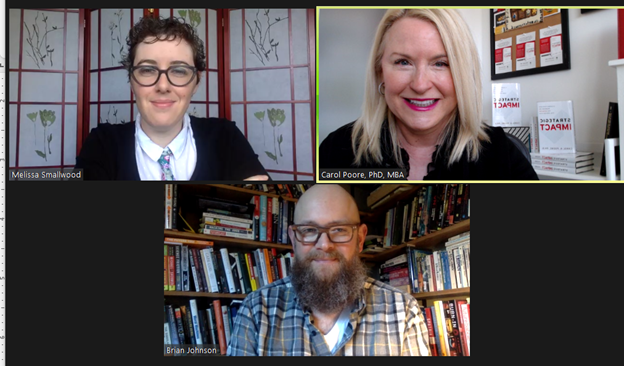One of my favorite parts of strategic planning involves engaging participants from the get-go.
When a strategic planning session is kicked off with a group of participants who feel valued for sharing contributions, the whole process becomes super-charged with enthusiasm and innovation.
Here are three incredibly easy steps you can take to ensure your planning process begins with an explosion of inspiration and inclusiveness, setting the stage for a more productive outcome.
First, weeks before the meeting, ask all individual participants or small-group teams to complete some organization-focused “homework” and bring it to the meeting. This could involve competitive intelligence, a SWOT analysis[1], a list of BHAGs[2]… but whatever it is, make sure it’s valuable and plan to use it in some way during your meeting. This increases personal ownership and teamwork and allows each participant to contribute to the planning session. And, this can help reduce your workload!
Then, when your meeting begins, make sure that all participants introduce themselves. Believe it or not, this is an often-forgotten step as staff, board members, guest speakers and others arrive and plow right into what they think may be a long, tedious meeting! Ask each participant to state three things in one minute or less such as name, job/title/etc., and how recent planning of ANY kind helped to shape his or her life. Or, you could ask each participant to share one, big insight learned from their “homework.” (Yes, this can be accomplished in a minute or less if you set the boundary!) Icebreakers can be fun, but these can eat up precious time.
The result: This creates openness as people learn about each other. Each individual is recognized as an important part of the planning experience from the get-go.
Second, following introductions, invite a compelling guest speaker or panel to share a fast-paced kickoff keynote focused on external trends impacting your industry followed by brief Q&A.
The result: A trends speaker or impressive panel can help unify the group around external forces impacting your organization. By understanding competitive forces, your team then can more effectively focus inwardly on your organization with a clearer mandate for the future.
Third, take charge and facilitate a “brainstorm and bucket” session focused on the visionary future in a perfect world – if there were no risks of failing. Ask the group, “What visions or visionary accomplishments do participants desire for the organization in three to five years?”
Set a ground rule that there are NO wrong answers in considering this visionary horizon. Call on raised hands and ask individuals to shout out their visionary thoughts while two or three participants serve as scribes to capture each and every idea on Post-It slips. Let the exercise go on until no further ideas are being shouted out. Be patient during pauses … give people a chance to really think. When ideas are exhausted, have the group help sort the Post-It notes onto five, blank flipchart pages posted on a nearby wall. Give everyone a few Post-It notes and ask them to self-sort by theme. Soon, you’ll see the major visionary themes! Label (or title) each chart and observe the themes as a group. This entire exercise should be able to be completed in 30 minutes.
The result: Your key visionary themes become a platform for further discussing trends, competitive threats, and strategic goals. By now, your group should be charged up and looking forward to the rest of the day.
[1] SWOT: Strengths, Weaknesses, Opportunities, Threats.
[2] BHAG: Big, Hairy, Audacious Goals.




